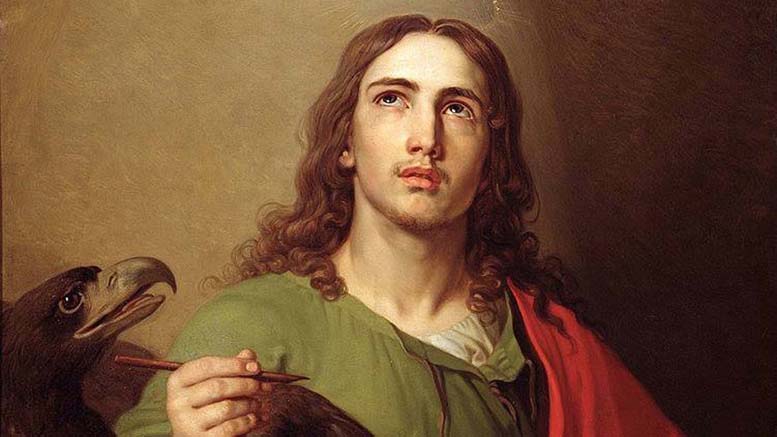Last Updated on July 26, 2019 by Editor
By A.J. VALENTINI
In the weeks following Easter, we heard several of the passages from St. John, “the one that Jesus loved,” and the youngest of the first Apostles.
In art we see him at the foot of the cross and asleep on Jesus’ chest at the Last Supper. This writer often thinks of him as Christ’s “chosen little brother.” In fact, from the cross, Jesus charges him to take care of Mary, his mother, and to Mary he says John shall now be her son. (John 19:27)
John’s real parents were Zebedee and Salome. His biological brother was James (The Greater), another apostle. The brothers were followers of John the Baptist.
It is John who reports that when Jesus came into the presence of the Baptist, he proclaimed, “Behold the Lamb of God!” (John 1:35). John and his friend Andrew asked Christ where he lived, to which Jesus responded to follow him. That was the beginning of the devotion of John to Jesus.
John was with Jesus at the marriage at Cana, the Transfiguration and the raising of the daughter of Jairus from the dead.
John, along with Peter and James, were Christ’s closest followers. They were with him in the Garden of Gethsemane. Seeing the closeness of their bond, John and James’ mother was emboldened to ask if her sons might sit at the right and left of Jesus in Paradise (Matthew 20:21). The brothers were given the honorific title, “Boanerges” — or “Sons of Thunder” (Mark 3:17 and Luke 9:9:14) — for their zeal (others say for their feistiness).
John and Peter were the first to get the news from Mary Magdalene of Christ’s Resurrection (John 20:2). When they rushed to the tomb to verify the news, John charged ahead arriving there first. Later, when seven of the Apostles were fishing, it was John who first recognized Christ standing on the shore.
One day, John and Peter went to the temple together (Acts 3:1). At the gate a man who had been lame for 40 years asked them for alms. Peter said he had no money to give but, “what I have, that I give in the name of Jesus Christ of Nazareth, arise and walk.” The man did and the surrounding crowd made a huge fuss over the miracle.
Peter, speaking on his own and John’s behalf, admonished them saying that it was through no power of their own that this happened but through the power of God through Jesus. And Jesus was the man they had given up to Pilate. When he didn’t give them the justice they wanted, they further entreated him to let the mob have him and dispatch him.
The Sadducees hearing this brought Peter and John before the Jewish officials who said the Apostles had no authority to preach and do miracles. This only energized Peter and John. Peter made the famous statement acclaiming the legitimacy of Christ: “This is the stone that was rejected by you, the builders, which has become the cornerstone (of the church).” (Acts 4:11) They told Peter and John to stop mentioning the name of Jesus. Again, Peter and John held their ground saying, “Whether it is right in the sight of God to listen to you rather than to God, decide for yourselves. For we cannot but speak of what we have heard.” (Acts 4:19-20).
There was no way to punish the two as the evidence, a well-known “cripple” was standing together with the Apostles and there was a crowd of witnesses, was more than they could control.
John continued his missionary work among the Jews. He and Peter were the first to convert the Samaritans, whom they had formerly despised, into the Christian fold. Paul asked recognition of his conversion and mission from John and James (the Lesser). John also faithfully cared for Mary all the days of her earthly life.
John remained in Jerusalem but upon the deaths of Peter and Paul he moved to Ephesus. During the persecutions of Domitian he was taken to Rome, and tradition says he was placed in a cauldron of boiling oil but emerged unscathed. He was then sent to work in the mines of Patmos. When Nerva became emperor, he was set free and went back to Ephesus where he wrote his gospel.
John died at a very old age, and just before he passed, in front of the congregation of Ephesus, he requested, “Little children, love one another.” In the 6th century, dust from the tomb of John in Ephesus was sought for its healing powers.
Paul recognized John along with Peter and James the Lesser as the “Pillars of the Church.” In iconography, John often is pictured with a chalice; he was, after all present at the last supper. Often, the chalice has a dragon emerging from it alluding to a legend that someone tried to poison him once, but the potion had no effect. Another common symbol of John is the eagle, symbol of master of the heavens.
Sources: Catholic Online, Encyclopedia Britannica, Catholic Encyclopedia: New Advent.
